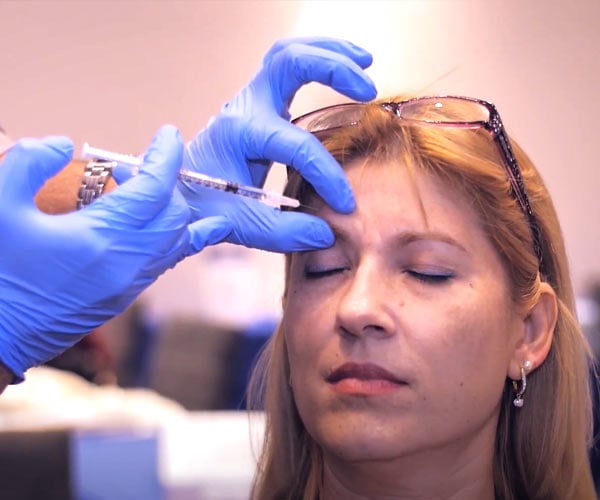Where to Inject Botox® for Marionette Lines
By Dr. Stephen Cosentino
PRESIDENT OF EMPIRE MEDICAL TRAINING
Botox® and similar botulinum toxin A-derived medications have gained widespread approval from the U.S. Food and Drug Administration and other health authorities for treating a variety of cosmetic and medical conditions. As a medical professional, understanding the intricacies of Botox administration is essential for providing safe and effective treatment to your patients.
Understanding Botox and Its Applications
Botox is a versatile treatment that can address conditions affecting various parts of the body, including the face, head, underarms, lower abdomen, and even the soles of the feet. Its wide range of applications emphasizes the importance of thorough training and knowledge for clinicians administering Botox injections.
Common Cosmetic Applications
- Forehead lines
- Glabellar lines (frown lines between eyebrows)
- Crow's feet (wrinkles around eyes)
- Nasolabial folds (smile lines)
- Marionette lines (lines around mouth)
- Neck bands
Medical Applications
- Chronic migraines
- Hyperhidrosis (excessive sweating)
- Jaw clenching and TMJ disorders
- Cervical dystonia
- Blepharospasm (eyelid spasms)
- Overactive bladder
Common Botox Injection Sites and Dosing Guidelines
While specific injection sites and dosages may vary based on individual patient needs, here are some general guidelines for common treatment areas:
Facial Areas
- Forehead: 10-20 units, distributed across 5-10 injection points
- Glabella: 20-30 units, distributed across 5 injection points
- Crow's feet: 10-15 units per side, distributed across 3-4 injection points
- Bunny lines (nose): 5-10 units, distributed across 2-4 injection points
Non-Facial Areas
- Axillae (for hyperhidrosis): 50 units per axilla, distributed across 10-15 injection points
- Masseter (for jaw clenching): 40-60 units per side, distributed across 3-5 injection points
- Neck bands: 25-50 units, distributed across 5-10 injection points
General Injection Guidelines
Regardless of the specific treatment area, certain universal guidelines should be followed when administering Botox:
- Use sterile technique and appropriate needle size
- Avoid blood vessels and stay within the target muscle
- Inject slowly and steadily to minimize discomfort
- Maintain consistent depth across injection sites
- Avoid massaging the area immediately after injection
Specific Considerations for Different Injection Sites
Each Botox injection site requires unique considerations and techniques. For example:
Lower Eyelid Injections
When injecting the lower eyelid area, it's essential to tauten the skin by gently pulling it back with your non-dominant hand. This creates a smooth injection field and helps ensure accurate placement.
Forehead and Crow's Feet Injections
When treating the lower forehead or crow's feet areas, exercise caution to avoid injecting too close to the upper orbital bone. Misplacement in this region can lead to ptosis (eyelid droop), an undesirable complication.
Pre-Treatment Evaluation and Injection Site Mapping
Before administering Botox, a thorough patient evaluation is necessary. This process should include:
- Reviewing the patient's medical history and current medications
- Assessing the patient's facial anatomy and muscle movement
- Discussing the patient's desired outcomes and expectations
- Determining if the patient is a suitable candidate for treatment
- Mapping out injection sites based on individual patient characteristics
During the pre-treatment evaluation for facial injections, ask patients to make various facial expressions while referring to a facial anatomy guide. This helps identify the optimal injection sites for each patient's unique muscle structure and movement patterns.
Patient Suitability and Contraindications
Not all patients are suitable candidates for Botox treatment. Exclusion criteria may include:
- Neuromuscular disorders (e.g., myasthenia gravis, Lambert-Eaton syndrome)
- Active infection at the proposed injection site
- Known allergy or sensitivity to botulinum toxin or other ingredients in the formulation
- Pregnancy or breastfeeding
- Unrealistic expectations or body dysmorphic disorder
Medications That May Interfere with Botox Treatment
Certain medications may increase the risk of complications or reduce the effectiveness of Botox treatment. These include:
- Blood thinners (e.g., warfarin, heparin)
- Muscle relaxants
- Some antibiotics (e.g., aminoglycosides)
- Calcium channel blockers
- Cholinesterase inhibitors
Potential Side Effects and Complications
While Botox is generally safe when administered by a qualified professional, patients should be informed of potential side effects and complications, which may include:
Common Side Effects
- Temporary bruising or swelling at the injection site
- Mild headache
- Dry mouth or eyes
- Flu-like symptoms
Less Common Side Effects
- Asymmetrical facial expressions
- Eyelid drooping (ptosis)
- Difficulty swallowing or speaking
- Muscle weakness in treated areas
Rare but Serious Complications
In rare cases, botulinum toxin may spread beyond the injection site, potentially causing more severe symptoms such as:
- Difficulty breathing or swallowing
- Loss of bladder control
- Vision problems
- Generalized muscle weakness
Post-Treatment Care and Follow-Up
After botox injections, it's important to:
- Monitor patients for immediate complications
- Provide clear post-treatment instructions, including:
- Avoiding strenuous physical activity for at least 24 hours
- Refraining from rubbing or massaging the treated area
- Staying upright for several hours post-treatment
- Schedule a follow-up appointment to assess results and address any concerns
- Instruct patients to contact you if they experience any unusual symptoms or side effects
Conclusion
Mastering the art of Botox administration requires a deep understanding of facial anatomy, injection techniques, and patient assessment. By following these guidelines and continuously updating your knowledge through accredited botox courses, you can provide safe and effective Botox treatments to your patients while minimizing the risk of complications.


